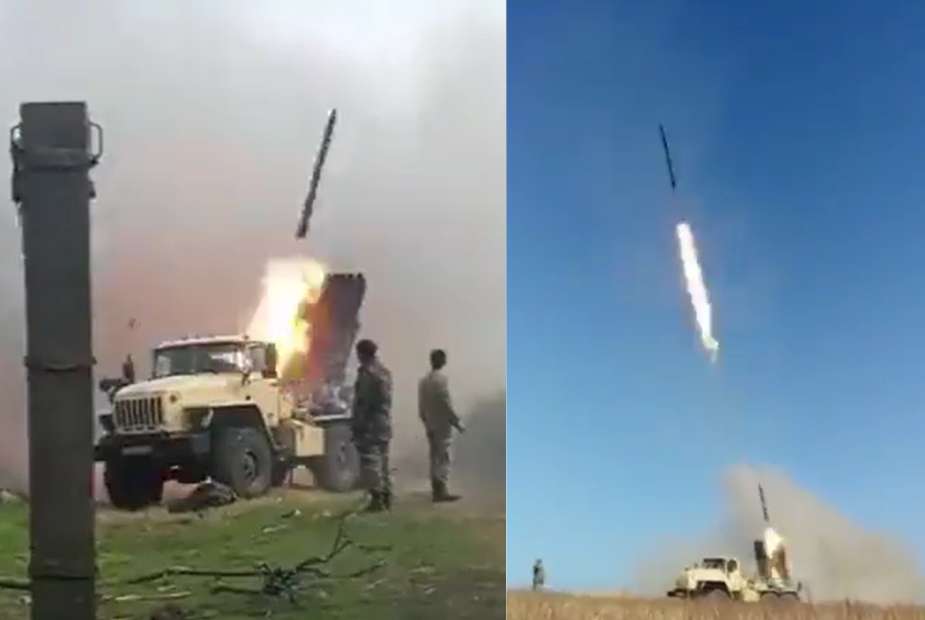Breaking news
Azerbaijan deploys Pakistani-made KRL-122 MLRS against Armenian positions.
According to a tweet by Conflict Watch PSF on September 5, 2023, Azerbaijani Armed Forces have deployed the KRL-122 Ghazab 122mm Multiple Launch Rocket System (MLRS) in a recent incident related to the Nagorno-Karabakh conflict, amid growing tensions between Azerbaijan and Armenia in this region. The KRL-122 Ghazab is based on the Russian BM-21 Grad.
Follow Army Recognition on Google News at this link

Azerbaijan forces deploy Pakistani-made KRL-122 MLRS against Armenian positions (Picture source: Conflict Watch PSF/Twitter)
The KRL-122 is a rocket launcher system based on the BM-21 Grad MLRS system, initially mounted on an Isuzu truck chassis and later adapted to the Reo M35 truck platform. Some sources refer to this system as Gadab. The KRL-122 can launch both original Soviet rockets and the indigenous Yarmuk Rocket developed by Pakistan Ordnance Factories. It has the capability to reach a maximum range of over 40 kilometers with its enhanced 122mm rockets.
This rocket launcher can be mounted on vehicles or used as a trailer-mounted system for towing convenience. In this specific instance, it appears to be based on a Ural-375D six-by-six truck chassis, like the original BM-21 Grad. It is powered by a water-cooled V-8 180 hp gasoline engine ZIL-375. The truck can achieve a maximum road speed of 80 km/h, has a range of up to 800 kilometers on road, and can ford depths of up to 1.5 meters.
The KRL-122 features an electric firing mechanism that can be operated from within the vehicle's cabin or remotely from a sheltered position located approximately 50 to 60 meters away from the launcher, using a cable-connected remote-control device. It offers a 180° traverse capability and can adjust elevation from 0 to 55°, providing both electric and manual control options.
With 30 tubes for launching rockets, the KRL-122 predominantly uses standard 122mm Grad fin-stabilized rockets manufactured by Pakistan Ordnance Factories. Additionally, the system is capable of firing the 122mm HE (MBRL) Yarmuk rocket, designed for ground-to-ground engagements. The Yarmuk rocket is intended for use against personnel and light materials, delivering a combination of fragmentation and blast effects. It features a caliber of 122mm, a weight of the filled warhead ranging from 18.4 kg without a fuze to 19.4 kg with a fuze, a propellant weight of 20.4 kg, a total rocket length of 2,875 mm, and a complete rocket weight of approximately 66 kg. It can reach a muzzle velocity of 400 meters/second and has a range of 20 kilometers, with a back blast extending up to 50 meters to the rear.
The Nagorno-Karabakh conflict represents a longstanding territorial conflict pitting Azerbaijan against its Armenian-majority population, backed by Armenia. This contention has deep historical roots, originating more than a century ago when tensions arose between Christian Armenians and Muslim Turkic Azeris.
In the early 20th century, Karabakh, an area historically inhabited by both Christian Armenians and Turkic Azeris, came under Russian jurisdiction. During the 1920s, following World War I and the Bolshevik revolution, Soviet authorities established the Nagorno-Karabakh Autonomous Region within the Soviet Socialist Republic of Azerbaijan, despite its predominantly Armenian populace.
The situation escalated dramatically in 1991, coinciding with the dissolution of the Soviet Union. At this juncture, Karabakh declared itself an autonomous republic, igniting a full-fledged conflict between Armenian and Azerbaijani forces. These hostilities, spanning from 1992 to 1994, resulted in substantial casualties and culminated with Armenians taking control of Nagorno-Karabakh and surrounding Azerbaijani territories. A truce, facilitated by Russia in 1994, left Nagorno-Karabakh and its neighboring regions under Armenian administration, yet it was accompanied by a large-scale displacement of inhabitants from their residences.
From 1994 to 2020, the region remained in a fragile ceasefire status, sporadically disrupted by armed confrontations. In 2017, a plebiscite led to the adoption of a new constitution, altering the official designation from Nagorno Karabakh Republic to the Republic of Artsakh, with both titles recognized. In 2020, a new phase unfolded with the eruption of the Second Karabakh War. Azerbaijan initiated a military campaign that resulted in the reclamation of territory in the vicinity of Karabakh. To oversee the truce, including the strategically vital "Lachin corridor" that links Nagorno-Karabakh to Armenia, Russian peacekeepers were dispatched.
In 2022, skirmishes transpired along the Armenia-Azerbaijan border, resulting in casualties on both sides. Disagreements surfaced concerning the Lachin corridor. Armenia contended that an Azerbaijani blockade had engendered a humanitarian crisis in the area, while Azerbaijan advocated for separate routes for civilian and cargo transport. The Nagorno-Karabakh conflict persists without resolution, and international initiatives, such as those by the OSCE's Minsk Group and the European Union, have made limited headway. Russia, France, and the United States, as members of the Minsk Group, face complications due to Russia's involvement in the Ukraine conflict, casting uncertainty on its mediation role in Nagorno-Karabakh.


























